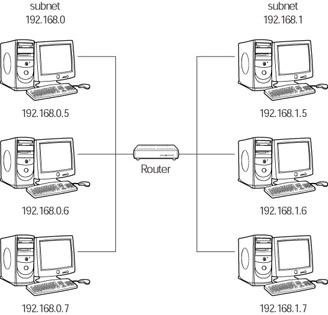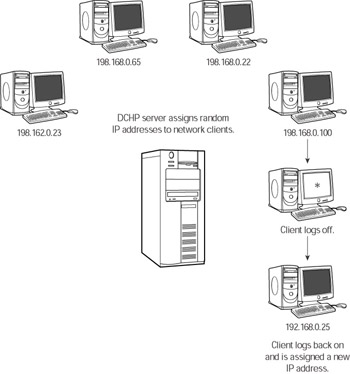Understanding Network Addresses and Names
Understanding Network Addresses and Names
For data to reach its destination, it has to have a destination address. The IP describes addressing on TCP/IP networks. The domain name system (DNS) translates numeric IP addresses into human-readable addresses. This section describes IP and domain addresses.
Explaining IP addresses
Now it’s time for your crash course in Internet Protocol addresses. Don’t worry. It is a brief and mostly painless introduction to what IP addresses are and how they function.
IP addresses are a 32-bit dotted decimal, with each byte separated by a decimal point. That is, every IP address is written as four numbers (each up to three digits) separated by a decimal point or dot; for example, 255.255.255.0. Your IP address can be permanent, or your Internet service provider (ISP) can dynamically reassign it each time you reboot or reconnect (using DHCP).
Because of the way data travels over the Internet, each computer must have a unique IP address. For example, your computer’s IP address may look something like this:
209.179.50.123
Demystifying address classes
In the beginning, the powers that be (or in this case, were) divided IP addresses into hierarchal classes. The idea of address classes came before we all had networked PCs; it hasn’t worked that well, with class A and B addresses running low.
Class A address numbers range from 1 through 127, class B ranges from 128 through 191, and class C ranges from 192 through 223. (Don’t worry about remembering this; it’s just nice to know. There won’t be a test later.)
-
Class A addresses 0.0.0.0 to 127.255.255.255
-
Class B addresses 128.0.0.0 to 191.255.255.255
-
Class C addresses 192.0.0.0 to 223.255.255.255
The following address ranges are reserved for intranet (internal) addresses that are used on internal networks like your WLAN. These address ranges aren’t routable over the Internet.
-
10.0.0.0 to 10.255.255.255
-
172.16.0.0 to 172.31.255.255
-
192.168.0.0 to 192.168.255.255
Exposing restricted addresses
Certain IP addresses are restricted; you can’t use them when assigning addresses to your network hosts. These addresses are:
-
255.255.255.255
-
0.0.0.0
-
127.0.0.0
The first number, 255.255.255.255 represents all 1’s in binary, and the second number 0.0.0.0 represents all zeros (I know, you guessed that). The first number is a broadcast address. Hosts on a network can use a broadcast address to send data to every host on that network segment. For example, if my subnet, or section of the network that I am connected to is 192.168.0.0, the broadcast address for my subnet would be 192.168.255.255. The second number, all zeros, can’t be used because zeros are used to designate a network segment, like my example subnet above (192.168.0.0). I explain subnets in detail in the section that follows.
The third number, 127.0.0.0, is a loopback address, which is used when a machine needs to communicate with itself. No, really, this is used for testing and analysis of network connections. Some machines default to the more common 127.0.0.1 as the loopback address.
Explaining subnets
Administrators often divide large networks into smaller segments called subnets or subnetworks. Subnets improve performance and security by limiting the number of nodes on each network segment. Subnets are usually traversed by routers (see Figure 2-7).

Figure 2-7: Subnets
Each host’s IP address consists of two parts: the network prefix that identifies the subnet and the host portion of the address of an individual node. Figure 2-7 illustrates two subnets. In each subnet, the first three numbers separated by decimals represent the network prefix that identifies that subnet. The last number identifies the individual host, which is demonstrated in Table 2-2.
| Subnet | Hosts |
|---|---|
| 192.168.0.x | 192.168.0.5 |
| 192.168.0.6 | |
| 192.168.0.7 | |
| ...etc | |
| 192.168.1.x | 192.168.1.5 |
| 192.168.1.6 | |
| 192.168.1.7 | |
| ...etc |
Masking subnets
Subnet masking is a technique used in the IP to determine which addresses are available for hosts. The subnet mask is a binary pattern stored on hosts or routers. Your subnet mask represents the portion of the IP address range that refers to subnet addresses, leaving the remaining digits available for hosts’ addresses (see Figure 2-8).

Figure 2-8: Subnet mask
The preceding figure illustrates the default subnet mask (255.255.255.0). The first three numbers (255.255.255) represent the part of the IP address range that identifies subnets, and the last number (0) identifies hosts on that subnet. This means that with the example IP address — 192.168.0.15 — the numbers 192.168.0 identify the subnet. The number 15 identifies the host on that subnet.
Dynamic host configuration protocol
To access the Internet or connect to a local area network (LAN), each client must have an IP address. The Dynamic Host Configuration Protocol (DHCP) automates this and assigns IP addresses to WLAN clients as they connect to the network. The dynamic addresses change each time a client connects to the WLAN after a reboot, for example, or each client can be “leased” an IP address for a period of time determined by the network administrator (see Figure 2-9).

Figure 2-9: DHCP services
With DHCP enabled, you don’t have to assign an IP address to each machine manually. The DHCP server assigns a random address within a specified range (for example, a subnet). An ISP uses DHCP to assign dial-up users an IP address when they dial in. After the user disconnects, the DHCP recycles the address and assigns it to another user.
Domain names
IP addresses are great for routers and other computers; they work with numbers without any problem. Human beings, on the other hand, have an easier time remembering words than dotted decimal addresses. That’s where DNS comes to our rescue.
DNS links IP addresses to human readable domain names. For example, if you wanted to purchase this book (or my other book) from the publisher, it’s much easier for you to remember the domain name wiley.com than to have to remember the IP address of 208.215.179.146.
DNS servers maintain lists of domain names and their corresponding IP addresses. When you use your browser to visit a Web site, your ISP sends that request through its DNS server, which then looks up the appropriate IP address so that you can communicate with the correct server.
Machines work with numbers, people remember words, and DNS keeps both happy.
Root domains
Domain names are comprised of labels separated by dots. The right-most label that follows the last dot is the root or top-level domain (TLD). Originally there were seven TLDs; .com, .net, .org, .edu, .gov, .int, and .mil. In 2001 and 2002, seven new TLDs were introduced; .biz, .info, .name, .pro, .aero, .coop, and .museum.
Subdomains and host names
Web addresses include subdomains and host names, as well as TLDs. Working from the far right of the domain name, the network identification gets increasingly specific. The label immediately to the left of the TLD is the domain, which can be preceded by a subdomain (or subnet), and that preceded by an individual host name(see Figure 2-10).

Figure 2-10: A fully qualified domain name including the host
EAN: 2147483647
Pages: 145